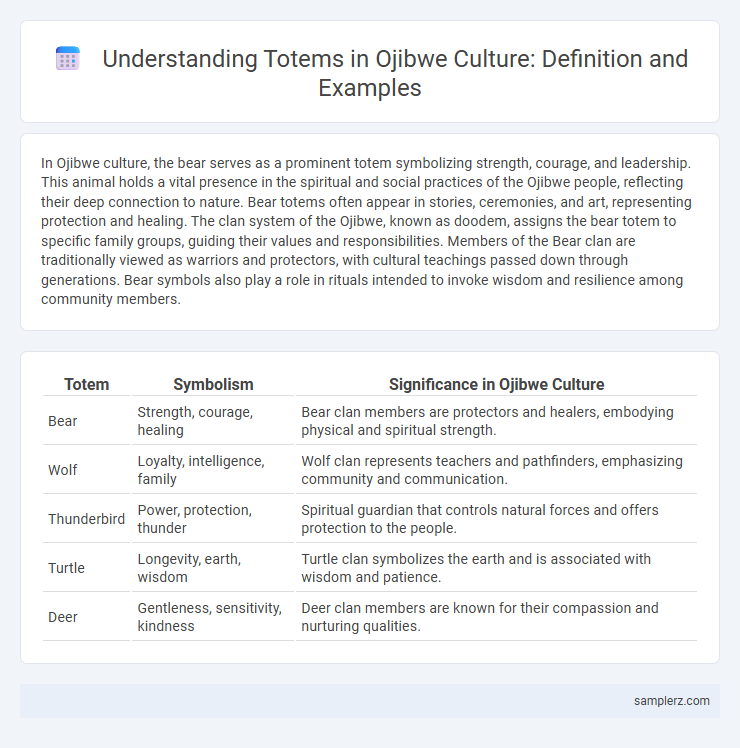In Ojibwe culture, the bear serves as a prominent totem symbolizing strength, courage, and leadership. This animal holds a vital presence in the spiritual and social practices of the Ojibwe people, reflecting their deep connection to nature. Bear totems often appear in stories, ceremonies, and art, representing protection and healing. The clan system of the Ojibwe, known as doodem, assigns the bear totem to specific family groups, guiding their values and responsibilities. Members of the Bear clan are traditionally viewed as warriors and protectors, with cultural teachings passed down through generations. Bear symbols also play a role in rituals intended to invoke wisdom and resilience among community members.
Table of Comparison
| Totem | Symbolism | Significance in Ojibwe Culture |
|---|---|---|
| Bear | Strength, courage, healing | Bear clan members are protectors and healers, embodying physical and spiritual strength. |
| Wolf | Loyalty, intelligence, family | Wolf clan represents teachers and pathfinders, emphasizing community and communication. |
| Thunderbird | Power, protection, thunder | Spiritual guardian that controls natural forces and offers protection to the people. |
| Turtle | Longevity, earth, wisdom | Turtle clan symbolizes the earth and is associated with wisdom and patience. |
| Deer | Gentleness, sensitivity, kindness | Deer clan members are known for their compassion and nurturing qualities. |
Origins of Totemism in Ojibwe Culture
The origins of totemism in Ojibwe culture trace back to ancient animistic beliefs where clans identified with specific animal spirits, such as the bear, loon, or wolf, symbolizing their lineage and spiritual guardianship. These totems served as powerful emblems guiding social structure, moral conduct, and community rituals within Ojibwe society. Embedded deeply in oral traditions, Ojibwe totems reflect a profound connection with nature and the spiritual world, emphasizing respect and reciprocity between humans and animals.
The Significance of Totems to Ojibwe Identity
The bear totem holds profound significance in Ojibwe culture, symbolizing strength, courage, and healing, essential traits that shape individual and communal identity. Totems like the bear serve as spiritual guides, connecting Ojibwe people to their ancestral heritage, natural world, and tribal values. This deep relationship fosters a strong sense of belonging and continuity within Ojibwe society.
Common Ojibwe Totem Animals and Their Meanings
Common Ojibwe totem animals include the bear, symbolizing strength and leadership, while the wolf represents loyalty and intelligence. The loon signifies peace and tranquility, and the turtle is associated with protection and longevity. Each animal totem embodies unique spiritual guidance and lessons central to Ojibwe cultural beliefs.
Clan Systems and Totemic Classification
The Ojibwe culture features a complex Clan System known as the Doodem, where totems represent animal spirits serving as clan identifiers and spiritual guides. Each clan, such as the Crane, Bear, or Loon, symbolizes specific traits and responsibilities within the community, reinforcing social structure and kinship bonds. Totemic classification in the Ojibwe tradition integrates these animal symbols deeply into cultural identity, spiritual beliefs, and governance.
The Role of Totems in Ojibwe Mythology
In Ojibwe culture, totems play a crucial role in connecting individuals and clans to spiritual symbols and ancestral teachings. Animal totems such as the Bear, Eagle, and Turtle serve as guides, embodying traits like strength, wisdom, and protection that are central to Ojibwe mythology. These totems not only represent personal identity but also maintain the harmony between humans, nature, and the spirit world.
Totems in Ojibwe Art and Symbolism
Ojibwe totems are central to their art and symbolism, often representing clan identities through animal figures like the bear, eagle, and raven, which embody traits such as strength, wisdom, and transformation. These totemic symbols appear in intricate beadwork, wood carvings, and birch bark scrolls, serving as visual narratives that preserve cultural heritage and spiritual beliefs. Totems also function as sacred emblems, guiding social roles and reinforcing community bonds within Ojibwe society.
Spiritual Connections between Clans and Totems
The Ojibwe culture features distinct totems representing spiritual connections between clans, such as the Bear, Crane, and Loon, each embodying specific ancestral traits and guiding principles. Clan members believe these totems serve as protectors and spiritual guides, influencing social roles, responsibilities, and ceremonies within the community. This deep bond between clans and their totems reinforces identity, unity, and the transmission of cultural values in Ojibwe tradition.
Totem Markings and Their Cultural Importance
Totem markings in Ojibwe culture serve as symbolic representations of clan identity, spiritual beliefs, and ancestral lineage, often depicted through intricate animal designs like the bear, wolf, and loon. These markings, found on birchbark scrolls, wooden carvings, and personal regalia, function as visual narratives that preserve oral traditions and convey social roles within the community. Their cultural importance lies in fostering a sense of belonging, guiding behavior, and maintaining the continuity of Ojibwe heritage across generations.
Totemic Traditions in Ojibwe Ceremonies
Totemic traditions in Ojibwe ceremonies prominently feature the Bear Totem, symbolizing strength, healing, and protection within the community. Ceremonial practices often involve the Bear Dance, which honors the spirit of the bear to invoke guidance and ward off illness. These rituals reinforce social bonds and spiritual connections to the natural world, central to Ojibwe cultural identity.
Teaching Ojibwe Values through Totem Stories
Totem stories in Ojibwe culture serve as vital tools for teaching values such as respect, courage, and humility through symbolic animal figures like the bear, loon, and wolf. Each totem animal embodies specific traits and lessons that guide ethical behavior and community responsibilities for younger generations. These narratives foster cultural continuity by connecting learners to Ojibwe spirituality and traditional ecological knowledge.

example of totem in Ojibwe culture Infographic
 samplerz.com
samplerz.com